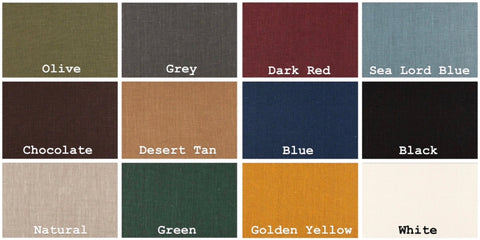Costume Guidelines
At War of the Barons, we want to tell a really incredible story through an immersive experience. A huge part of the immersion is the personal equipment of individual players. Therefore it is very important to us that everyone steps onto the battlefield looking authentic to the vision of the event. We expect all players and staff to do their utmost to present themselves in a quality costume, both for their own sake and the sake of everyone else at the event.
These are the general guidelines for all participants. To see the requirements for your specific role please see either the Combatant Costume Guidelines or the Non-combatant Costume Guidelines. All items including clothing, weapons, and camping equipment that are going to be brought into the game area must be pre-approved via email by your Baron. We highly recommend you get approval by using links, drawings, and photos before purchasing or creating any costume.
Color
Garments may be worn in any color as long as your surcoat/tabard is the appropriate color/colors of your Baron for combatants. Non-combatants are more color restricted so please see those rules for details. Colors should be natural looking and made of natural quality materials. We highly recommend looking at the color palette for Fell & Fair products found at shop.fellandfair.com this is the color palette that the War of the Barons staff will be using for all heraldry. We also recommend that base garments such as trousers and tunics be of natural muted tones such as gray, natural, brown, and tan. We highly discourage the use of deep black cotton as deep black dye was very rare at the time. Black wool however can be used by the church.
Material
Approved materials for garments include linen, wool, and cotton (rustic/rough weaves preferred) Leather should be used for belts (or rope for monks). Synthetic materials such as polyester and faux leather are not allowed.
Weapons
All weapons should be professionally made foam combat weapons (no boffer/homemade) they should look appropriate to the 12/early 13th century. So no fantasy, curved blades, or large two-handed swords, halberds. Swords, maces, axes, and spears are allowed for Barons, Knights, and Men-at-Arms. Archers may carry swords, maces, and axes as backup weapons to their bows.
Shields
Shields should be heater or kite shields appropriate to the early 13th century. Barons and Knights’ shields should be 90cm x 60cm or less as they specialized in horseback combat and usually had smaller shields. Men-at-Arms are allowed to have larger shields if they are of the appropriate design. Shield bosses were generally phased out at this point in history so are to be avoided. All shields should be appropriately painted with the colors or coat of arms of your barony. Do not leave visible latex or unpainted foam. Check out this VIDEO and this VIDEO on how to paint foam shields.
Armor
Helmets should be made of steel; chainmail is allowed to be made in steel or aluminum. If chainmail is made out of aluminum it should be properly weathered to look like steel. The rings should be 8mm-10mm rings (no Ringmesh). Gambesons may be made of fabric, however not of poly blends or pre-quilted fabric. Archers may wear leather bracers for shooting. For more specifics see the combatant costume requirements.
Bows
Archers shall carry a medieval-type or period appropriate English longbow. The max allowable Draw-weight is 35# @ 28”. No modern or compound, recurve, crossbows or horse bows allowed. All arrows must be the IDV-style “low speed” or flat sponge-tipped type. Removable/modular/screw-on arrowheads are not allowed. All arrowheads must be permanently affixed to the shaft. All weapons must be visually approved through our costume approval process before the event and will be safety inspected before and throughout the event.
Recommended Costume Items
You can RENT most of the items you need here! Below is a list of recommended costume items. These are pre-approved for the event. Even if you do not intend to buy any of these, it should hopefully give you inspiration as to what direction to go when costuming.
Overgarments
